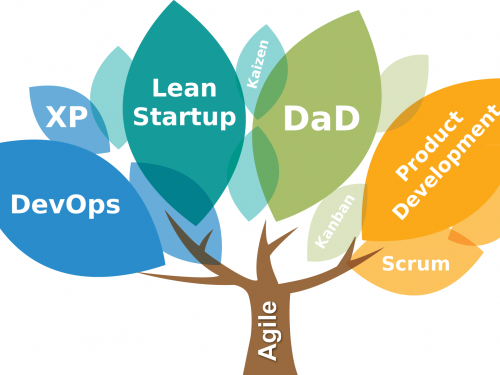
A Guide To Agile Project Management Methodology & Tools
At a ski resort in the U.S. state of Utah, in February 2001, 17 software professionals who dubbed themselves “The Agile Alliance” came together to develop what they called a “Manifesto for Agile Software Development”. The document, which emphasizes four values and 12 principles, is now known as the Agile Manifesto. While the individuals who met in Utah were not the pioneers of the agile principle in general, they did solidify the values that had been brewing for some time in the background in the software development world. Today, the agile methodology has permeated almost every industry. To understand how the agile approach can be applied in the project management field and to traditional projects, we took some time to focus on what the methodology is all about. We focus on the four values and 12 principles upon which the agile philosophy was built. We will also discuss the differences between the agile and waterfall approach, and consider some popular agile project management methodologies. Lastly, we name our top 10 agile tools of 2020.

What Is The Agile Approach?
In project management, the agile approach is a product development process that takes an iterative loop. The agile project management framework draws its unique flavor from its lack of a rigid structure.
Rather than following a linear path as other project management methodologies might, the approach encourages being responsive and adapting to changes that may occur at any point in the project life cycle or within a development cycle.
The agile and waterfall (or traditional) approaches to project management differ primarily in their structure. This primary difference is noted by the Association for Project Management (APM), which notes that while the waterfall approach will “treat scope as the driver and calculate the consequential time and cost,” agile “commits set resources over limited periods to deliver products that are developed over successive cycles.”
There are primarily four values that make the agile approach to project management different from traditional approaches:
- People are the most important stakeholders in the agile rulebook, not the processes and tools used in completing a project.
- Agile is client-centric. It prioritizes the achievement of results as opposed to rigidly sticking to contracts.
- Agile is an extremely responsive approach, favoring flexibility over rigid structures in general.
- Agile places a premium on problem-solving over record-keeping.
Key Components Of Agile
For it to ensure that people are the most important stakeholders and clients are taken along, the agile project management approach subscribes to five primary components:
User stories: In line with its customer-centric approach, agile uses a short outline written from a client’s perspective to estimate how much work needs to be done and what the final product should look like.
Sprints: These are periodic short iterations (usually lasting one to three weeks) to improve and upgrade a product or service. Stand-up meetings: Also called “daily Scrum meetings,” are short meetings where team members tell each other what part of the project they are currently working on. The meeting usually lasts under 10 minutes and is done while standing to preserve its brevity.
Agile board: Can be a physical board or a project management software function used to keep track of team progress.
Backlogs: Are outstanding tasks in the system. In the sprint planning process, any backlog stories will be moved into the sprint where responsible software developers or other team members work on them. In software development, this is often referred to as the product backlog.
The 12 Fundamental Principles Of Agile
When the software professionals, who met in 2001 in Utah, created the Agile Manifesto, they introduced the 12 principles and agile values that still underpin today’s philosophy:
- Customer satisfaction through delivery of value, done consistently, and at the right time.
- Embracing change, no matter when it comes during the development process, and harnessing this change for the customer’s benefit.
- Delivering projects frequently, while ensuring that the shortest time possible is spent completing a project.
- Daily collaboration among all relevant stakeholders is a necessity, including customer collaboration.
- An enabling environment built on trust and support is necessary to keep individuals motivated to build projects.
- Have face-to-face conversations whenever possible, as this is the most effective means of communication.
- Success is measured by having a final working product or working software.
- Agile processes spur sustainable development. All team members must maintain a consistent pace indefinitely.
- Consistently focusing on sound design and technical excellence enhances agility.
- Simplicity – doing the most with the least amount of effort – is imperative.
- Requirements are met, and the best architectures and designs are birthed through self-organizing teams.
- Frequent introspection on how to become more efficient, with behavioral adjustments to boot, are necessary for teams.
Popular Agile Methodologies
We discovered that there are over 50 agile methodologies. This implies that even though we can talk about an “agile methodology,” the reality is that the concept means different things to different people.
By the term methodology, we refer to the system or strategy used by a development team or project team that follows the agile approach. Here are some of the most popular agile methods:
Scrum
Scrum is an agile framework that uses sprints and daily meetings (also known as Scrum ceremonies) at intervals to address distinct portions or a set amount of work within a project during its life cycle. There are three leading roles in Scrum: the Scrum master (the leader), the product owner (who could be the client), and the scrum team members (the individuals developing the product).
Kanban
The Kanban method is based on the visual display of current tasks, future tasks, and completed tasks on a kanban board. The visual display’s main advantage is that it assists agile team members not only in seeing where their tasks are, but also other tasks related to their project.
Lean
As the name implies, the lean development method aims to keep a project trimmed by discouraging waste. This helps to keep the system clutter-free while improving the flow of value. Other popular agile methodologies with agile practices are eXtreme Programming, Crystal, Scrumban, and the Dynamic System Development Method (DSDM). There are even some advocates of agnostic agile, a framework that prioritizes what’s best for the software development project, rather than a specific agile methodology.
Primary Steps In Agile
Even though diverse teams may implement the agile approach differently, some necessary steps should be included:
Planning Projects and Creating Product Maps
All stakeholders need to understand the goals and values of a project by the time the project begins. Elements that need to be understood include the scope of the project and its various components. This is achieved by creating a roadmap that will contain all the deliverables needed to create the final product.
Another idea that needs to be clear at the planning phase is the estimated timeline for releases. During each sprint, stakeholders convene at a sprint planning meeting to discuss the task ahead, how team goals will be achieved, and what needs to change.
Daily Stand-ups
The daily stand-up meetings are for team members to discuss the previous day’s achievements and the plans for the present day. If there are any delays anticipated, the team deals with such issues in these meetings.
Sprint Reviews
Usually, the team holds two meetings at the end of each sprint. The first meeting involves all the individuals in the project so that the finished product can be presented. A second meeting (sometimes known as a sprint retrospective) seeks to evaluate the sprint by looking at each sprint’s strengths, weaknesses, and remedies.
Benefits Of Agile PM
The APM notes that the agile approach’s main advantage is that it “concentrates on empowered people and their interactions and early and constant delivery of value into an enterprise”. The same association lists other benefits:
- Builds engagement between clients and end users and supports organizational culture change
- Reduces waste, allowing for a lighter weight framework
- Greater flexibility, thus enhancing project control
- Quicker turnaround and rapid detection of issues
- Enhances accountability and diversity of ideas
The Top 10 Popular Agile PM Software
If the idea of agile project management appeals to you, you may want to try some of the best agile tools we could find on the market. To develop this list, we took some time to look at what each tool promises about agile project management and what reviews from users are saying:
1. Atlassian Jira
The developers of the Jira Software say that their product was developed to help project managers “plan, track, and release great software.” It provides real-time visual data that can be used to generate reports. It can also integrate with other workspace tools, such as “Confluence, Bitbucket, and hundreds of other developer tools.”
2. SprintGround
SprintGround highlights three tracking capabilities and three management tools as its main features. Issue and bug tracking, time tracking, and development progress tracking are SprintGround’s headline tracking features. The management department offers task management, collaborative real-time communication, and a feature that helps organize ideas and feedback.
3. VersionOne
VersionOne is a project management tool used for both tracking and maintaining records. It is designed to follow the phases of the agile process, allowing users to have an idea of the backlogs. It also allows them to evaluate the sprints and create reports.
4. Trello
The Trello interface is simple, allowing users to view all the information about a project at a glance using Trello cards. Trello also has an automated system called Butler, which helps to “remove tedious tasks from your to-do lists.”
5. Monday.com
Monday.com calls itself “the project management software for productive teams.” For teams following the agile approach, it offers templates like a project tracker, a project roadmap, cross-departmental project tracking, and resource management.
6. Asana
Asana provides users with a list view for organizing and assigning tasks, a timeline for managing schedules, and boards that the developers of the software tool say “make it easy for your team to focus on tasks currently at hand.”
7. Zephyr
According to the developers of the Zephyr Project Manager, it helps teams “set deadlines, set and share details, and create projects all in one place.” Team members can also collaborate by leaving comments and attachments, or checking where the different phases of a project are at any given time.
8. nTask
One of the reasons why nTask is on this list is that it has excellent features but still comes free. The tool allows for visualization of project plans using Gantt charts. It shows how the projects are related to each other, budgets, and milestones.
9. ProofHub
ProofHub promises teams that it will allow them to “easily plan, collaborate, organize and deliver projects of all sizes, on time, using one project planning software with all the right tools put in one place.”
10. LeanKit
LeanKit is a project management tool from Planview. It promises to help teams “apply lean management principles to their work, helping them work smarter and deliver faster”.
Article by Ben Aston.
Source: https://thedigitalprojectmanager.com/agile-project-management/
About Ben Aston
Ben Aston is a digital project manager and founder of thedigitalprojectmanager.com. He has been in the industry for more than 15 years working in the UK at London’s top digital agencies including Dare, Wunderman, Lowe and DDB. He has delivered everything from film to CMS’, games to advertising and eCRM to eCommerce sites. Ben has been fortunate enough to work across a wide range of great clients; automotive brands including Land Rover, Volkswagen and Honda; Utility brands including BT, British Gas and Exxon, FMCG brands such as Unilever, and consumer electronics brands including Sony.



